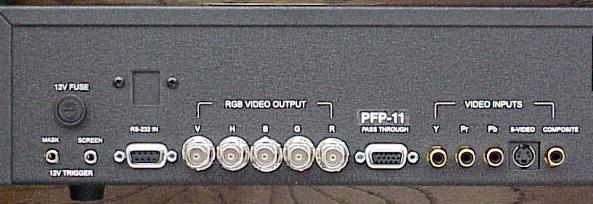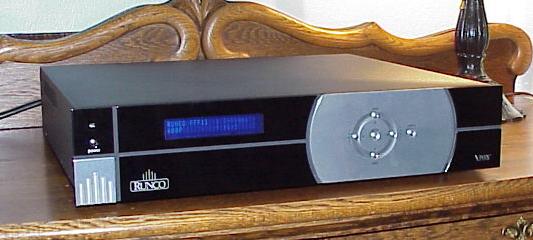Product Review - Runco ViVix PFP-11
Digital Video Processor (Deinterlacer & Scaler) - April, 2002
John E. Johnson, Jr.
![]()
|
|
Specifications: Output Resolutions: 852 x 480, 800 x 600, 1024 x 768, 1024 x 1024, 1280 x 720, 1280 x 768, 1280 x 1024, 1366 x 1024, 1366 x 768, 480p, 540p, 600p, 720p Inputs: Composite, S-Video, Component, Pass-Through (One Each); NTSC and PAL Aspect Ratios: Anamorphic, Letterbox, 4:3 Frequency Response: 5.5 MHz Size: 3 1/2" H x 17 1/2" W x 16" D Weight: 16 Pounds MSRP: $6,995 USA |
|
Runco International, 2463 Tripaldi Way, Hayward, California 94545; Phone 510-293-9154; E-Mail [email protected]; Web http://www.runco.com |
Introduction
As more and more consumers purchase large screen digital TVs, front projectors, and plasma screen TVs, we will need ancillary products to make sure we get the picture quality that we want. Just connecting the DVD player to a projector that gives a six foot image is not optimal. Also, the resolution of projectors varies widely, so we need to have something that really fine-tunes the signal coming out of various sources to that particular resolution. If you look at the specification table above, you will see how many resolutions are out there. The Runco ViVix PFP-11 is a deinterlacer/scaler that does the fine tuning.
The PFP-11 takes an interlaced signal from whatever source you have, such as composite from an old VCR, S-Video from the satellite box, and component from your DVD player, deinterlaces it, scales it to your specific TV resolution, and outputs it to the display device (your TV). The PFP stands for Pixel for Pixel, which means it will map the image exactly to the resolution of your particular display, for example, 1280 x 720 or 1366 x 768. All you need to do is choose the resolution of your display from the list in the setup menu of the PFP-11.
Why aren't such things already in the TV? Well, they are to a certain extent, but not at this quality. Just as we are able to pair a high-performance outboard DAC with any CD transport, this is a high-performance version of similar devices in the projector. Also, the outboard product has many more features than are likely in the projector, such as higher quality time-base correction, image-shift, blanking, gray side bars to prevent burn-in, and so on.
Connections
The rear panel of the PFP-11 has RCA input jacks for Y, Pr, and Pb, which are used for connecting to the corresponding jacks on the output of a DVD player, an S-Video jack, and a composite video RCA jack. Outputs are BNC for Red, Green, Blue, Horizontal Sync, and Vertical Sync. Some processors use all BNC, some have a combination like the PFP-11, and projectors vary too. The last one I reviewed had RCA inputs, while the one I used for this review (Zenith Pro 1200X) has BNC input jacks. Chances are about 50:50 you will need to make a trip to the electronics store for cable adapters. Fortunately, they are cheap, i.e., $2.49 each for BNC-to-RCA.

There are also RS-232 and pass-through connections, as well as triggers for such things as making the projector screen come down when you turn the system on.
Performance
The PFP-11 comes with a remote control, but I found that once things are set up, it is easier to just push a button on the front panel to do things like change the aspect ratio when going from anamorphic to non-anamorphic viewing. The simple things, like aspect ratio, are changed by a single button push, and for the more complicated things, like changing the resolution, you have to go through a couple of menu levels. I used the Zenith CRT projector so that I could try a bunch of resolutions. I assumed I would like 720p, but as it turned out, I preferred 600p. There was something about the image that I found more appealing at 600p. And this is one of the things you pay for with the PFP-11, namely a lot of choices. Also, the color saturation and black level on the Zenith are so good, I might not have noticed this difference if I had used a digital projector. Anyway, 600p it was.
Of course, the PFP-11 has tons of adjustments you can make to the picture, such as brightness, contrast, sharpness, color, tint, etc. We can get ourselves into trouble if we start adjusting these things on several components in series, i.e., the DVD player, the scaler and also the TV itself. So, I left the PFP-11 controls in a neutral setting. Not high, not low. Contrast and sharpness were left unaltered in the PFP-11, but adjusted with the projector's controls instead, when calibrating the picture for viewing. Edge enhancement in the DVD player was left in the off position.
One thing I really liked about this product was that I connected it, turned it on, and got a beautiful picture without any hassle. It worked right out of the box, with no glitches. The push buttons confused me a little at first, because they don't scroll through. Once you reach the end, you have to push the buttons on the opposite side of the panel to go through the selections in the opposite direction. Other than that, it is a very easy component to set up and use.
Click HERE to go to Part 2 - Test Results
![]()
©
Copyright 2002 Secrets of Home Theater & High Fidelity
Return to Table
of Contents for this Issue.


